Geophysical and Geochemical Pilot Study to Characterize the Dam Foundation Rock and Source of Seepage in Part of Pensacola Dam in Oklahoma
Abstract
1. Introduction
2. Site Description and Geology
3. Geophysical Data Acquisition and Processing
3.1. Data Acquisition inside Arch-16 and Arch-17
3.2. Data Acquisition from the Downstream Berm
3.3. Data Processing
4. Hydrogeochemical Investigation
5. Data Interpretations
5.1. Data Acquired Inside the Arches
5.2. Data Acquired from the Downstream Berm
5.3. Geochemical Analysis
6. Discussion
7. Conclusions
Author Contributions
Funding
Data Availability Statement
Acknowledgments
Conflicts of Interest
References
- Grand River Dam Authority (GRDA). Solutions for Evaluating, Monitoring, and Improving Dam Foundation Conditions of the Pensacola Dam, R.S. Kerr Dam, and the Salina Pumped Storage Project, No. 42584; Unpublished Technical Report; GRDA: Langley, OK, USA, 2022. [Google Scholar]
- Ouhichi, N.; Hamdi, R.; Lachaal, F.; Gabtni, H.; Grünberger, O. Geophysical and hydrogeological investigations of water leakage from a reservoir dam to a coastal aquifer: The Lebna Case Study (Northeastern Tunisia). Arab. J. Geosci. 2022, 15, 1192. [Google Scholar] [CrossRef]
- Zhang, H.; Jing, Y.; Chen, J.; Gao, Z.; Xu, Y. Characteristics and causes of crest cracking on a high core-wall rockfill dam: A case study. Eng. Geol. 2022, 297, 106488. [Google Scholar] [CrossRef]
- Haghighi, A.T.; Tuomela, A.; Hekmatzadeh, A.A. Assessing the Efficiency of Seepage Control Measures in Earthfill Dams. Geotech. Geol. Eng. 2020, 38, 5667–5680. [Google Scholar] [CrossRef]
- Ikard, S.J.; Rittgers, J.; Revil, A.; Mooney, M.A. Geophysical Investigation of Seepage Beneath an Earthen Dam. Groundwater 2014, 53, 238–250. [Google Scholar] [CrossRef]
- Sazal, Z.; Sanuade, O.; Ismail, A. Geophysical Characterization of the Carl Blackwell Earth-Fill Dam: Stillwater, Oklahoma, USA. Pure Appl. Geophys. 2022, 179, 2853–2867. [Google Scholar] [CrossRef]
- Raji, W.O.; Adedoyin, A.D. Dam safety assessment using 2D electrical resistivity geophysical survey and geological mapping. J. King Saud Univ. Sci. 2020, 32, 1123–1129. [Google Scholar] [CrossRef]
- Camarero, P.L.; Moreira, C.A.; Pereira, H.G. Analysis of the Physical Integrity of Earth Dams from Electrical Resistivity Tomography (ERT) in Brazil. Pure Appl. Geophys. 2019, 176, 5363–5375. [Google Scholar] [CrossRef]
- Rahimi, S.; Moody, T.; Wood, C.; Kouchaki, B.M.; Barry, M.; Tran, K.; King, C. Mapping Subsurface Conditions and Detecting Seepage Channels for an Embankment Dam Using Geophysical Methods: A Case Study of the Kinion Lake Dam. J. Environ. Eng. Geophys. 2019, 24, 373–386. [Google Scholar] [CrossRef]
- Camarero, P.L.; Moreira, C.A. Geophysical investigation of earth dam using the electrical tomography resistivity technique. REM Int. Eng. J. 2017, 70, 47–52. [Google Scholar] [CrossRef][Green Version]
- Dai, Q.; Lin, F.; Wang, X.; Feng, D.; Bayless, R.C. Detection of concrete dam leakage using an integrated geophysical technique based on flow-field fitting method. J. Appl. Geophys. 2017, 140, 168–176. [Google Scholar] [CrossRef]
- Loperte, A.; Soldovieri, F.; Palombo, A.; Santini, F.; Lapenna, V. An integrated geophysical approach for water infiltration detection and characterization at Monte Cotugno rock-fill dam (southern Italy). Eng. Geol. 2016, 211, 162–170. [Google Scholar] [CrossRef]
- Bedrosian, P.A.; Burton, B.L.; Powers, M.H.; Minsley, B.J.; Phillips, J.D.; Hunter, L.E. Geophysical investigations of geology and structure at the Martis Creek Dam, Truckee, California. J. Appl. Geophys. 2012, 77, 7–20. [Google Scholar] [CrossRef]
- Takamte, C.R.M.; Ntomba, S.M.; Atouba, L.C.O.; Bisso, D.; Ondoa, J.M. Geophysical and geological considerations for characterizing the dam foundation during the Memve’ele dam construction (southern Cameroon): Influence on the dam type retained. Environ. Earth Sci. 2022, 81, 343. [Google Scholar] [CrossRef]
- Cardarelli, E.; Cercato, M.; De Donno, G. Characterization of an earth-filled dam through the combined use of electrical resistivity tomography, P- and SH-wave seismic tomography and surface wave data. J. Appl. Geophys. 2014, 106, 87–95. [Google Scholar] [CrossRef]
- Loke, M.H.; Barker, R.D. Least-squares deconvolution of apparent resistivity pseudosections. Geophysics 1995, 60, 1682–1690. [Google Scholar] [CrossRef]
- Griffiths, D.H.; Barker, R.D. Two-dimensional resistivity imaging and modelling in areas of complex geology. J. Appl. Geophys. 1993, 29, 211–226. [Google Scholar] [CrossRef]
- Dey, A.; Morrison, H.F. Resistivity modeling for arbitrary shaped three-dimensional structures. Geophysics 1979, 44, 753–780. [Google Scholar] [CrossRef]
- Rehman, F.; Sherif, M.E.; Ali, H.A.; Hussein, M.H. Multichannel analysis of surface waves (MASW) for seismic site characterization using 2D genetic algorithm at Bahrah area, Wadi Fatima, Saudi Arabia. Arab. J. Geosci. 2016, 9, 519. [Google Scholar] [CrossRef]
- Guo, Y.; Cui, Y.-A.; Xie, J.; Luo, Y.; Zhang, P.; Liu, H.; Liu, J. Seepage detection in earth-filled dam from self-potential and electrical resistivity tomography. Eng. Geol. 2022, 306, 106750. [Google Scholar] [CrossRef]
- Vagnon, F.; Comina, C.; Arato, A. Evaluation of different methods for deriving geotechnical parameters from electric and seismic streamer data. Eng. Geol. 2022, 303, 106670. [Google Scholar] [CrossRef]
- Yari, M.; Nabi-Bidhendi, M.; Ghanati, R.; Shomali, Z.H. Hidden layer imaging using joint inversion of P-wave travel-time and electrical resistivity data. Near Surf. Geophys. 2021, 19, 297–313. [Google Scholar] [CrossRef]
- Himi, M.; Casado, I.; Sendros, A.; Lovera, R.; Rivero, L.; Casas, A. Assessing preferential seepage and monitoring mortar injection through an earthen dam settled over a gypsiferous substrate using combined geophysical methods. Eng. Geol. 2018, 246, 212–221. [Google Scholar] [CrossRef]
- Cardarelli, E.; Cercato, M.; De Donno, G. Surface and borehole geophysics for the rehabilitation of a concrete dam (Penne, Central Italy). Eng. Geol. 2018, 241, 1–10. [Google Scholar] [CrossRef]
- Martínez-Moreno, F.J.; Delgado-Ramos, F.; Galindo-Zaldívar, J.; Martín-Rosales, W.; López-Chicano, M.; González-Castillo, L. Identification of leakage and potential areas for internal erosion combining ERT and IP techniques at the Negratín Dam left abutment (Granada, southern Spain). Eng. Geol. 2018, 240, 74–80. [Google Scholar] [CrossRef]
- Abdulsamad, F.; Revil, A.; Ahmed, A.S.; Coperey, A.; Karaoulis, M.; Nicaise, S.; Peyras, L. Induced polarization tomography applied to the detection and the monitoring of leaks in embankments. Eng. Geol. 2019, 254, 89–101. [Google Scholar] [CrossRef]
- Al-Fares, W.; Al-Hilal, M. Integration of electrical resistivity tomography with electromagnetic and soil radon measurements for characterizing the leakage problem in Afamia B dam, Syria. Geofísica Int. 2018, 57, 275–287. [Google Scholar] [CrossRef]
- Ismail, A.; Anderson, N. 2-D and 3-D Resistivity Imaging of Karst Sites in Missouri, USA. Environ. Eng. Geosci. 2012, 18, 281–293. [Google Scholar] [CrossRef]
- Kemna, A.; Binley, A.; Slater, L. Crosshole IP imaging for engineering and environmental applications. Geophysics 2004, 69, 97–107. [Google Scholar] [CrossRef]
- Slater, L.D.; Lesmes, D. IP interpretation in environmental investigations. Geophysics 2002, 67, 77–88. [Google Scholar] [CrossRef]
- Ahmed, A.S.; Revil, A.; Bolève, A.; Steck, B.; Vergniault, C.; Courivaud, J.; Jougnot, D.; Abbas, M. Determination of the permeability of seepage flow paths in dams from self-potential measurements. Eng. Geol. 2020, 268, 105514. [Google Scholar] [CrossRef]
- Ahmed, A.S.; Revil, A.; Steck, B.; Vergniault, C.; Jardani, A.; Vinceslas, G. Self-potential signals associated with localized leaks in embankment dams and dikes. Eng. Geol. 2019, 253, 229–239. [Google Scholar] [CrossRef]
- Bogoslovsky, V.A.; Ogilvy, A.A. The study of streaming potentials on fissured media models. Geophys. Prospect. 1972, 20, 109–117. [Google Scholar] [CrossRef]
- Rittgers, J.B.; Revil, A.; Planès, T.; Mooney, M.A.; Koelewijn, A.R. 4-D imaging of seepage in earthen embankments with time-lapse inversion of self-potential data constrained by acoustic emissions localization. Geophys. J. Int. 2015, 200, 758–772. [Google Scholar] [CrossRef]
- Bolève, A.; Vandemeulebrouck, J.; Grangeon, J. Dyke leakage localization and hydraulic permeability estimation through self-potential and hydro-acoustic measurements: Self-potential ‘abacus’ diagram for hydraulic permeability estimation and uncertainty computation. J. Appl. Geophys. 2012, 86, 17–28. [Google Scholar] [CrossRef]
- Woolery, E.W. SH-Mode Seismic-Reflection Imaging of Earthfill Dams. Engineering 2018, 4, 694–701. [Google Scholar] [CrossRef]
- Busato, L.; Boaga, J.; Peruzzo, L.; Himi, M.; Cola, S.; Bersan, S.; Cassiani, G. Combined geophysical surveys for the characterization of a reconstructed river embankment. Eng. Geol. 2016, 211, 74–84. [Google Scholar] [CrossRef]
- Xia, J.; Cakir, R.; Miller, R.D.; Zeng, C.; Luo, Y. Estimation of near-surface shear-wave velocity by inversion of Love waves. In SEG Technical Program Expanded Abstracts; Society of Exploration Geophysicists: Houston, TX, USA, 2009. [Google Scholar]
- Lorenzi, V.; Barberio, M.D.; Sbarbati, C.; Petitta, M. Groundwater recharge distribution due to snow cover in shortage conditions (2019–22) on the Gran Sasso carbonate aquifer (Central Italy). Environ. Earth Sci. 2023, 82, 206. [Google Scholar] [CrossRef]
- Medici, G.; Langman, J.B. Pathways and Estimate of Aquifer Recharge in a Flood Basalt Terrain; A Review from the South Fork Palouse River Basin (Columbia River Plateau, USA). Sustainability 2022, 14, 11349. [Google Scholar] [CrossRef]
- Wu, X.; Li, C.; Sun, B.; Geng, F.; Gao, S.; Lv, M.; Ma, X.; Li, H.; Xing, L. Groundwater hydrogeochemical formation and evolution in a karst aquifer system affected by anthropogenic impacts. Environ. Geochem. Health 2020, 42, 2609–2626. [Google Scholar] [CrossRef]
- Domrocheva, E.V.; Kuzevanov, K.I.; Gridasov, A.G.; Sizikov, D.A. Hydrogeological conditions of Naryk-ostashkin area in Erunakovo region in Kuzbass. Bull. Tomsk Polytech. Univ.-Geo Assets Eng. 2018, 329, 134–142. [Google Scholar] [CrossRef]
- Mostafa, M.G.; Uddin, S.M.H.; Haque, A.B.M.H. Assessment of hydro-geochemistry and groundwater quality of Rajshahi City in Bangladesh. Appl. Water Sci. 2017, 7, 4663–4671. [Google Scholar] [CrossRef]
- Warth, P.; Polone, D.J. Soil survey of Adair County, Oklahoma; U.S. Department of Agriculture Soil Conservation Service Series; Facsimile Publisher: New York, NY, USA, 1965; 61p. [Google Scholar]
- Huffman, G.G. Geology of the flanks of the Ozark Uplift; Oklahoma Geological Survey Bulletin; Oklahoma Geological Survey: Norman, OK, USA, 1958; Volume 77, 281p. [Google Scholar]
- Marcher, M.V.; Bingham, R.H. Reconnaissance of the water resources of the Tulsa Quadrangle, Northeastern Oklahoma. Oklahoma Geological Survey Hydrologic Atlas 1971, 2, 4 Sheets, Scale 1:250,000. Available online: pubs.usgs.gov/wri/wri954150/pdf/wri954150.pdf (accessed on 1 November 2023).
- Osborn, N.I.; Minor Basin Hydrogeologic Investigation Report of the Boone Groundwater Basin; Northeastern Oklahoma. Oklahoma Water Resources Board Technical Report; 2001, GW2001-2. Available online: https://www.oklahoma.gov/content/dam/ok/en/owrb/documents/science-and-research/hydrologic-investigations/boone-2001.pdf (accessed on 1 November 2023).
- Grand River Dam Authority (GRDA). Report on Foundation Exploration and Geologic Design Parameters; Unpublished Technical Report; GRDA: Langley, OK, USA, 1995; Volume I, No. 1494-OK. [Google Scholar]
- Christenson, S.C. Contamination of Wells Completed in the Roubidoux Aquifer by Abandoned Zinc and Lead Mines, Ottawa County, Oklahoma. U.S. Geological Survey Water-Resources Investigations Report 1995-4150. 114p. Available online: chrome-extension://efaidnbmnnnibpcajpcglclefindmkaj/https://pubs.usgs.gov/wri/wri954150/pdf/wri954150.pdf (accessed on 1 November 2023).
- Grand River Dam Authority (GRDA). Supporting Technical Information Document for the Salina Pumped Storage Project, No. 2524; Unpublished Technical Report; GRDA: Langley, OK, USA, 2017. [Google Scholar]
- Mazzullo, S.J.; Boardman, D.R.; Wilhite, B.W.; Godwin, C.; Morris, B.T. Revisions of outcrop lithostratigraphic nomenclature in the Lower to Middle Mississippian subsystem (Kinderhookian to Basal Meramecian Series) along the shelf-Edge in Southwest Missouri, Northwest Arkansas, and Northeast Oklahoma. Shale Shaker 2013, 63, 414–454. [Google Scholar]
- Swindle, A. Water Chemistry of Selected Springs, Boone Aquifer, Delaware County, Oklahoma. Ph.D. Thesis, Oklahoma State University, Stillwater, OK, USA, 2003. [Google Scholar]
- Imes, J.L.; Emmett, L.F. Geohydrology of the Ozarks Plateaus Aquifer System in Parts of Missouri, Arkansas, Oklahoma, and Kansas. U.S. Geological Survey Professional Paper 1994, 1414-D. 127p. Available online: https://pubs.usgs.gov/pp/1414d/report.pdf (accessed on 5 November 2023).
- Loke, M.; Barker, R. Rapid least-squares inversion of apparent resistivity pseudosections by a quasi-Newton method1. Geophys. Prospect. 1996, 44, 131–152. [Google Scholar] [CrossRef]
- deGroot-Hedlin, C.; Constable, S. Occam’s inversion to generate smooth, two-dimensional models from magnetotelluric data. Geophysics 1990, 55, 1613–1624. [Google Scholar] [CrossRef]
- Geometrics. Seisimager/2D Refraction Software. 2019. Available online: https://www.geometrics.com/software/seisimager-2d/ (accessed on 18 October 2023).
- Sheehan, J.R.; Doll, W.E.; Mandell, W.A. An Evaluation of Methods and Available Software for Seismic Refraction Tomography Analysis. J. Environ. Eng. Geophys. 2005, 10, 21–34. [Google Scholar] [CrossRef]
- Zhang, J.; Toksöz, M.N. Nonlinear refraction traveltime tomography. Geophysics 1998, 63, 1726–1737. [Google Scholar] [CrossRef]
- Kansas Geological Survey 2019. Surfseis MASW Software. Available online: http://www.kgs.ku.edu/software/surfseis/index.html (accessed on 18 October 2023).
- Xiao, C.; Bancroft, J.C.; Brown, R.J. Estimation of Thomsen’s anisotropy parameters by moveout velocity analysis. In SEG Technical Program Expanded Abstracts 2005; Society of Exploration Geophysicists: Houston, TX, USA; pp. 194–197. [CrossRef]
- Treitel, S. The complex wiener filter. Geophysics 1974, 39, 169–173. [Google Scholar] [CrossRef]
- Richards, L.A. Diagnosis and Improvement of Saline and Alkali Soils. In USDA Handbook No. 60. 1954; US Government Printing Office: Washington, DC, USA, 1954. [Google Scholar] [CrossRef]
- Standard Methods for the Examination of Water and Wastewater (SMEWW), 19th ed.; American Public Health Association: Washington, DC, USA, 1995.
- Rittgers, J.B.; Revil, A.; Karaoulis, M.; Mooney, M.A.; Slater, L.D.; Atekwana, E.A. Self-potential signals generated by the corrosion of buried metallic objects with application to contaminant plumes. Geophysics 2013, 78, EN65–EN82. [Google Scholar] [CrossRef]
- Dahlin, T. 2D resistivity surveying for environmental and engineering applications. First Break. 1996, 14, 275–283. [Google Scholar] [CrossRef]
- Sjödahl, P.; Dahlin, T.; Zhou, B. 2.5D resistivity modeling of embankment dams to assess influence from geometry and material properties. Geophysics 2006, 71, G107–G114. [Google Scholar] [CrossRef]
- Yang, X.; Lagmanson, M. Comparison of 2D and 3D electrical resistivity imaging methods. In Proceedings of the Symposium on the Application of Geophysics to Engineering and Environmental Problems, Seattle, WA, USA, 2–6 April 2006; Society of Exploration Geophysicists: Houston, TX, USA; pp. 585–594. [Google Scholar]
- Hung, Y.-C.; Lin, C.-P.; Lee, C.-T.; Weng, K.-W. 3D and Boundary Effects on 2D Electrical Resistivity Tomography. Appl. Sci. 2019, 9, 2963. [Google Scholar] [CrossRef]
- Liu, G.; Lu, W.; Niu, X.; Wang, G.; Chen, M.; Yan, P. Excavation Shaping and Damage Control Technique for the Breccia Lava Dam Foundation at the Bai-he-tan Hydropower Station: A Case Study. Rock Mech. Rock Eng. 2020, 53, 1889–1907. [Google Scholar] [CrossRef]
- Wu, F.; Liu, T.; Liu, J.; Tang, X. Excavation unloading destruction phenomena in rock dam foundations. Bull. Eng. Geol. Environ. 2009, 68, 257–262. [Google Scholar] [CrossRef]
- Çelik, R. Impact of Dams on Groundwater Static Water Level Changes: A Case Study Kralkızı and Dicle Dam Watershed. Int. J. Eng. Res. Dev. 2018, 10, 119–126. [Google Scholar] [CrossRef]
- Janzen, K.; Westbrook, C.J. Hyporheic Flows Along a Channelled Peatland: Influence of Beaver Dams. Can. Water Resour. J. Rev. Can. Ressour. Hydr. 2011, 36, 331–347. [Google Scholar] [CrossRef]
- Quilis, R.O.; Hoogmoed, M.; Ertsen, M.; Foppen, J.W.; Hut, R.; de Vries, A. Measuring and modeling hydrological processes of sand-storage dams on different spatial scales. Phys. Chem. Earth Parts A/B/C 2009, 34, 289–298. [Google Scholar] [CrossRef]
- Yi, P.; Yang, J.; Wang, Y.; Mugwanezal, V.d.P.; Chen, L.; Aldahan, A. Detecting the leakage source of a reservoir using isotopes. J. Environ. Radioact. 2018, 187, 106–114. [Google Scholar] [CrossRef]
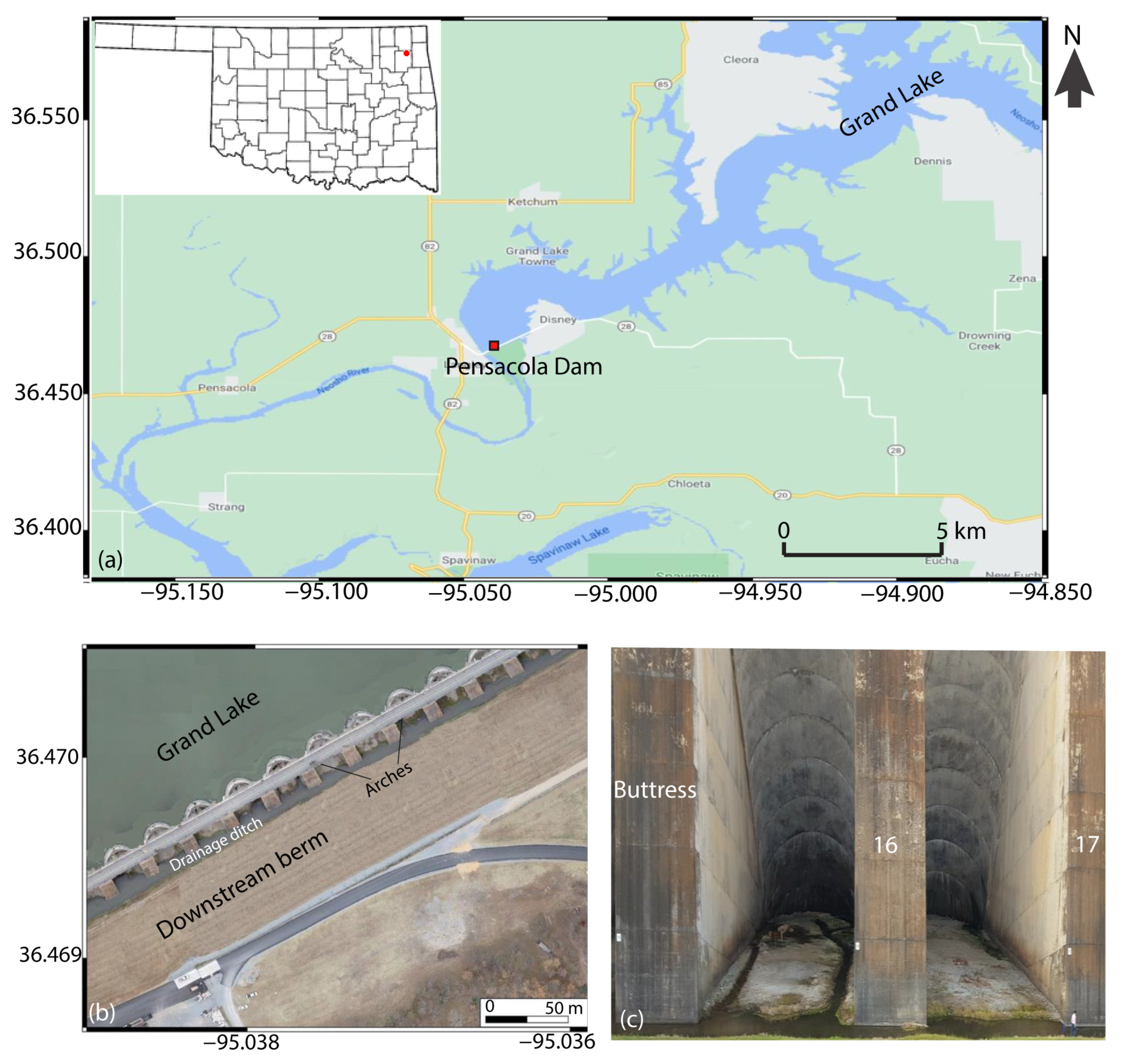
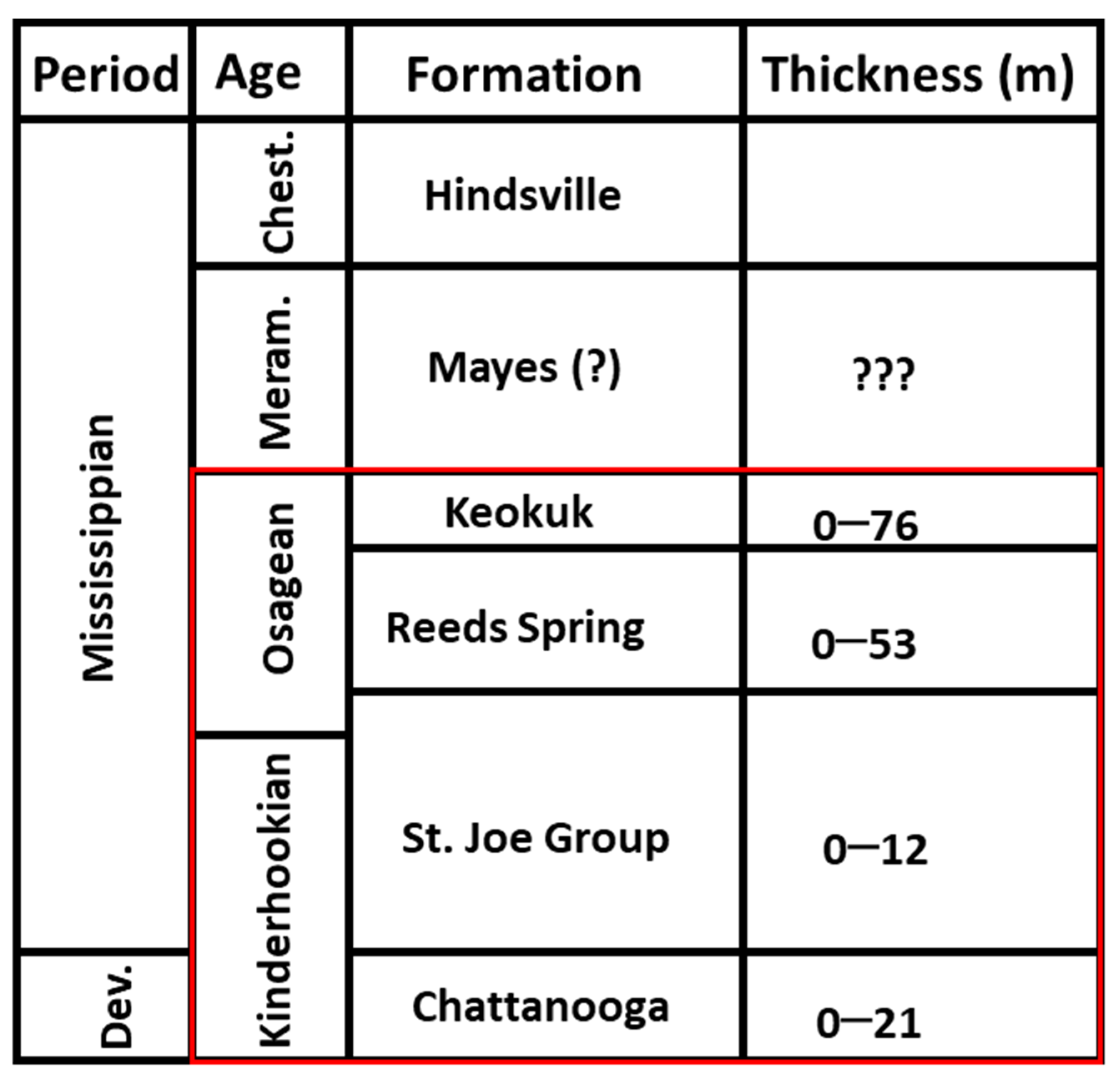
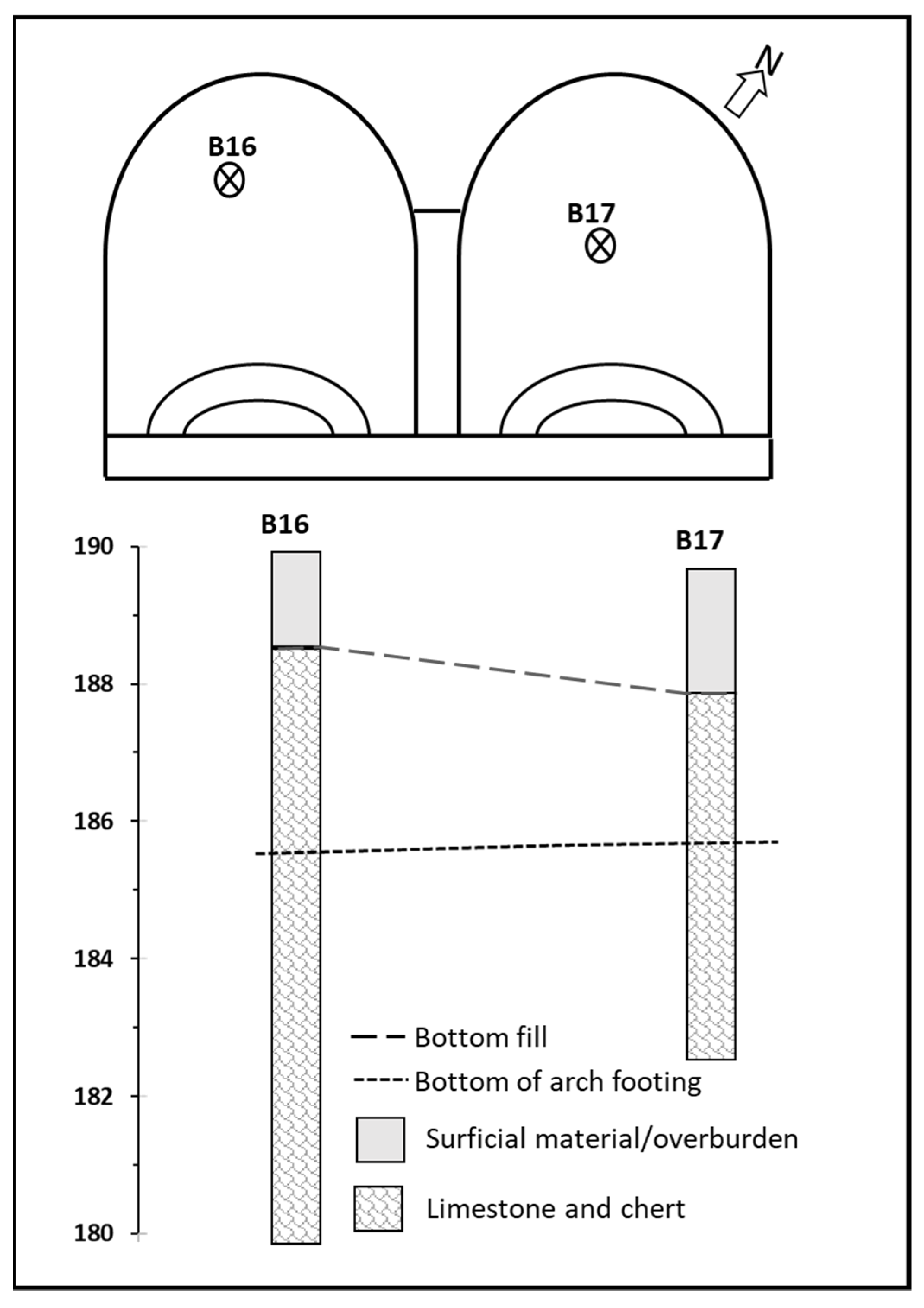
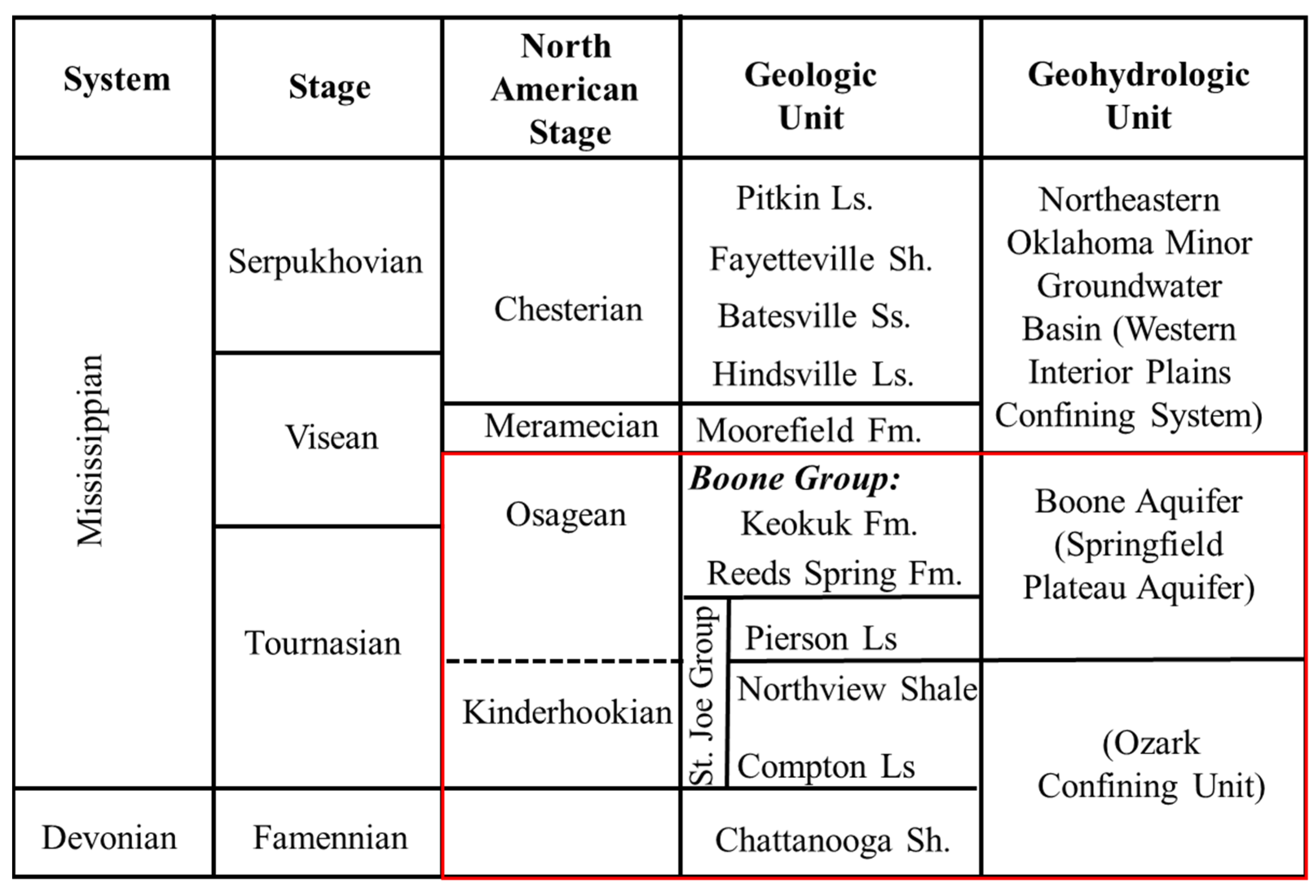
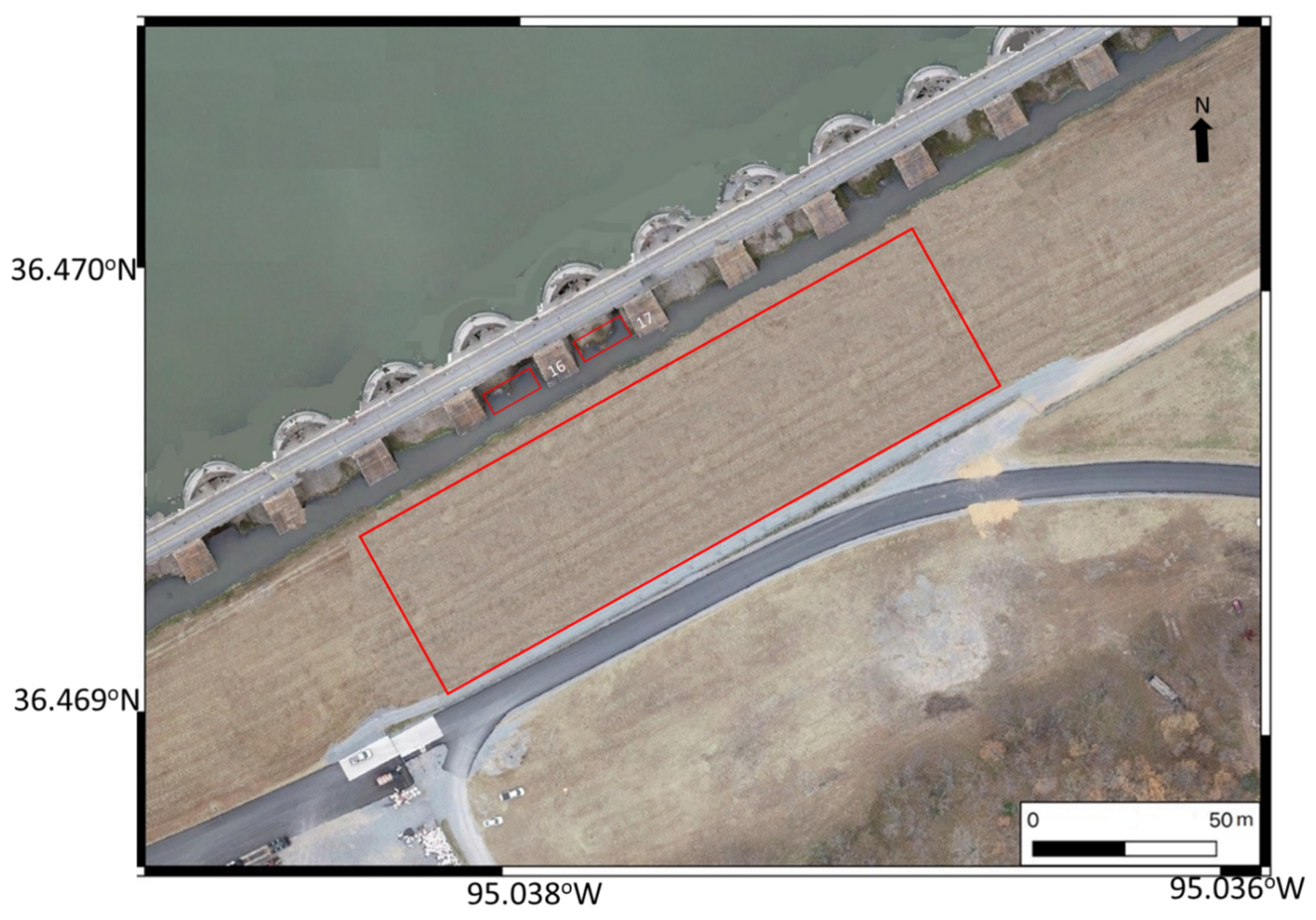
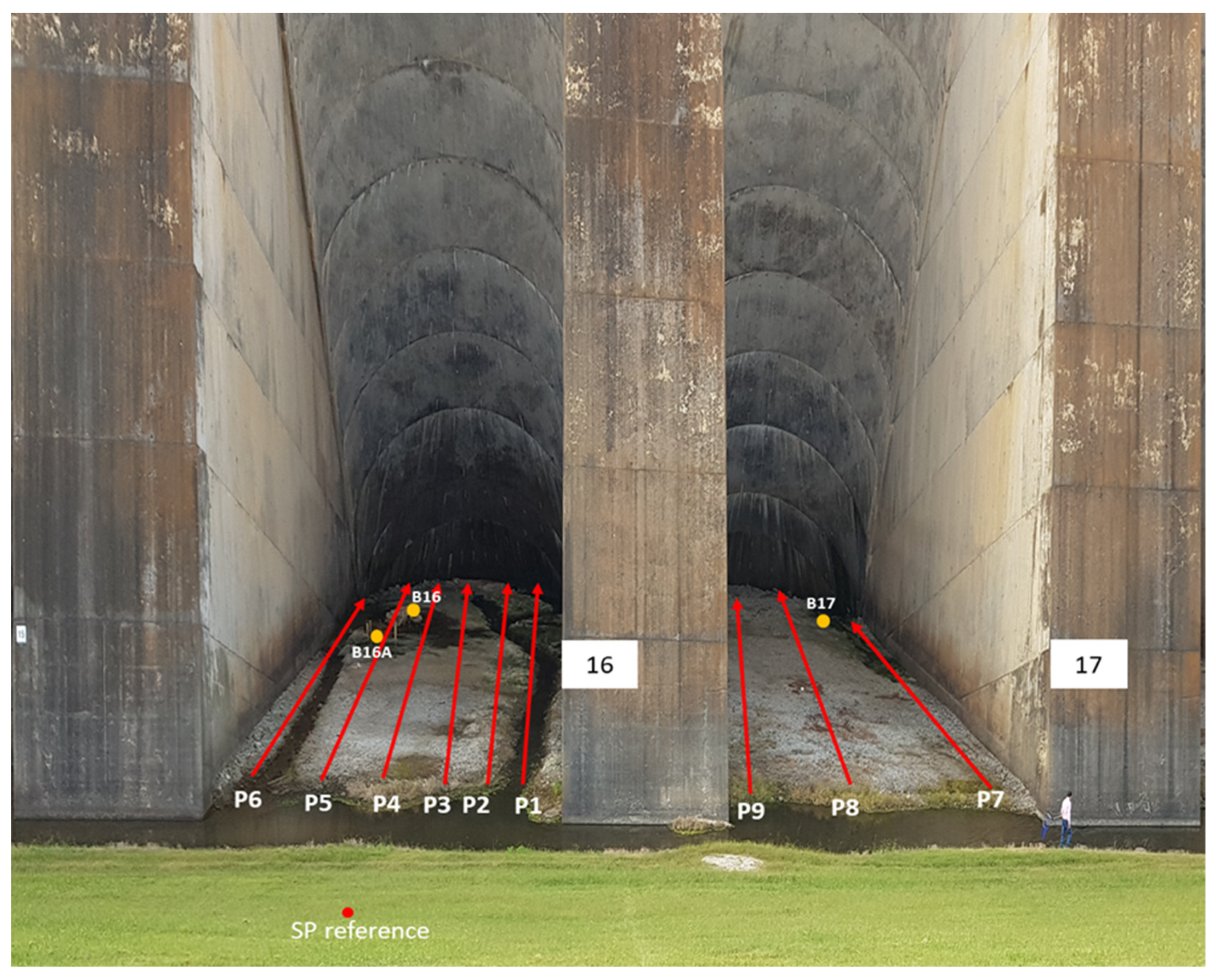
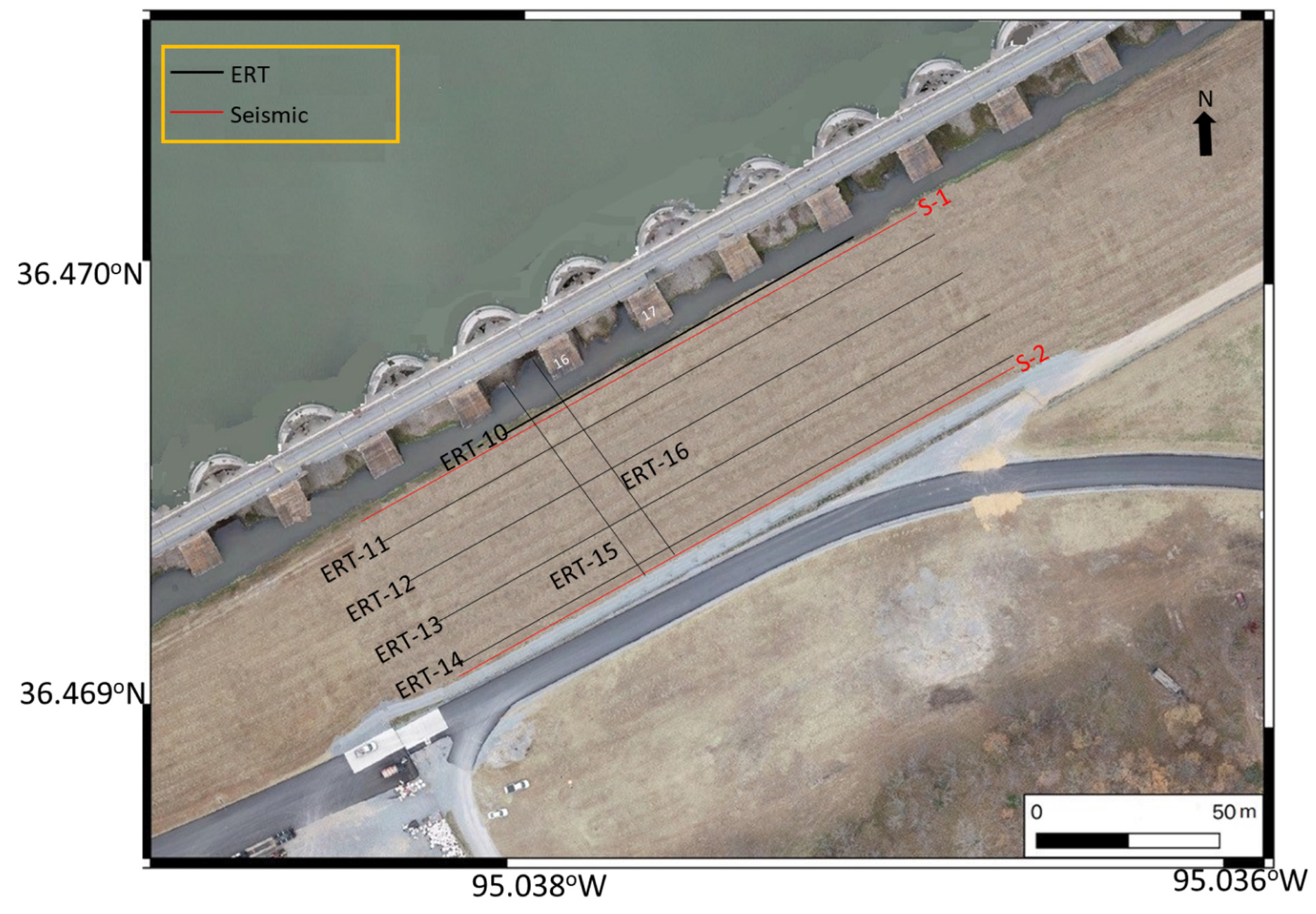
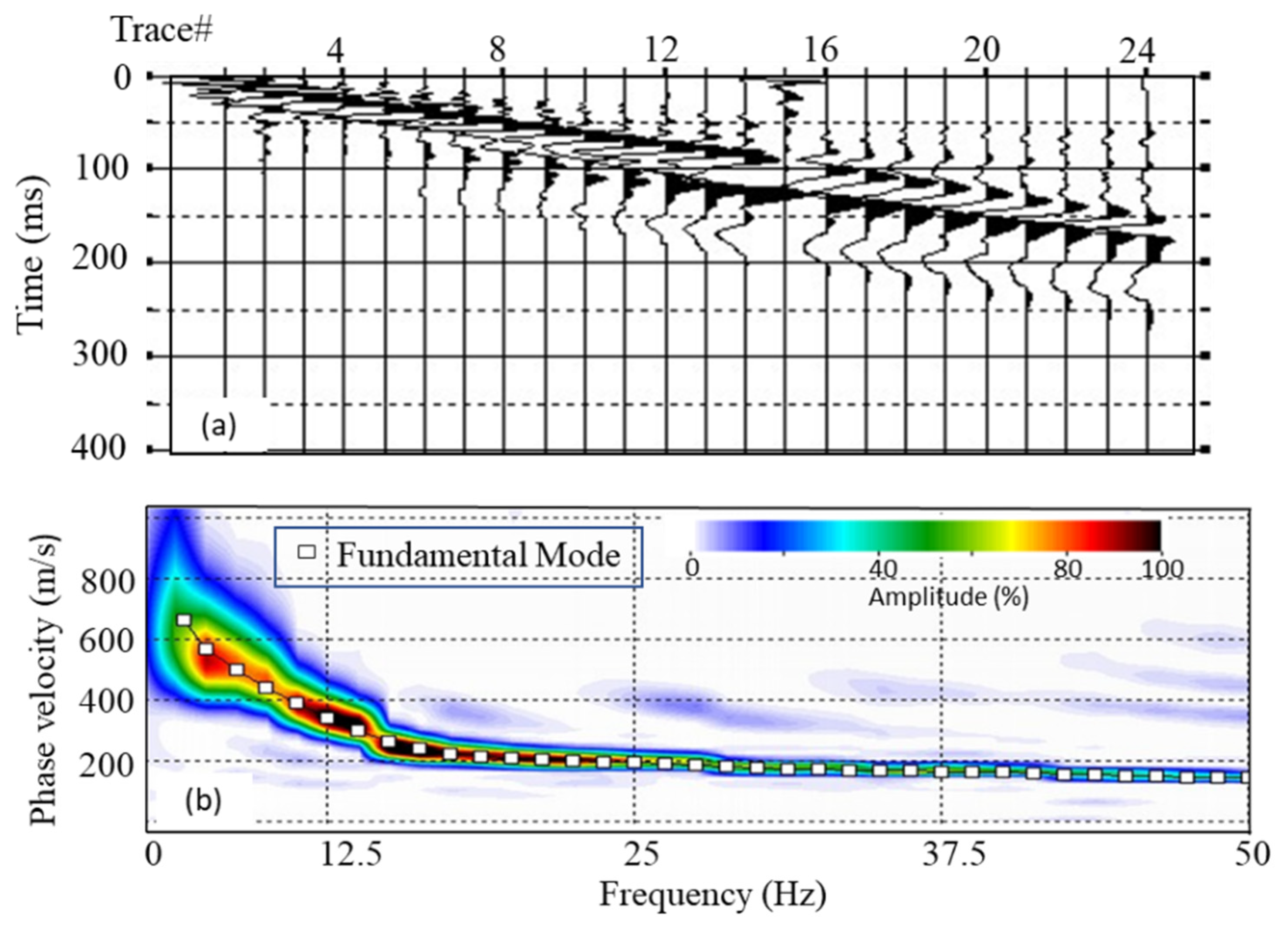
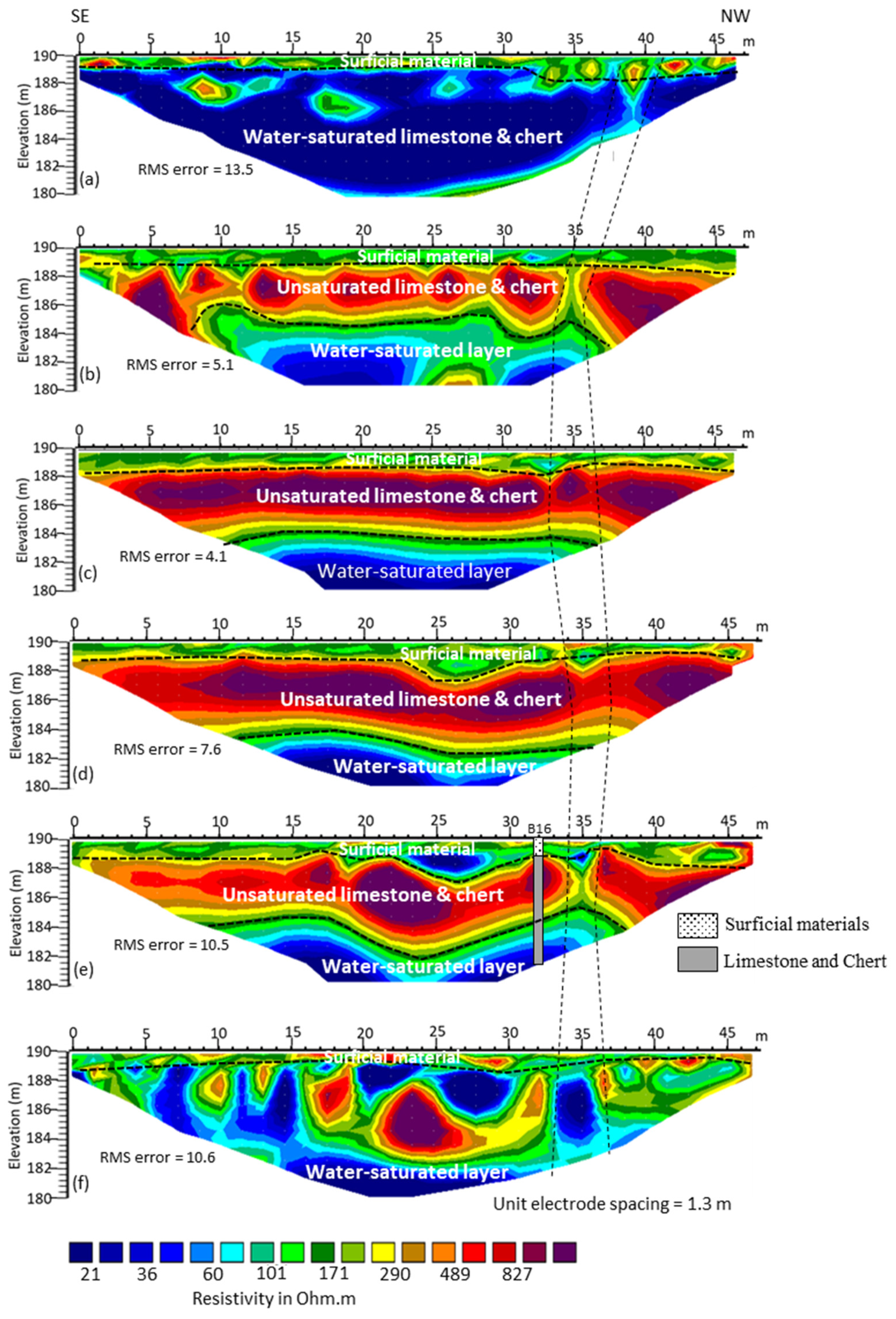
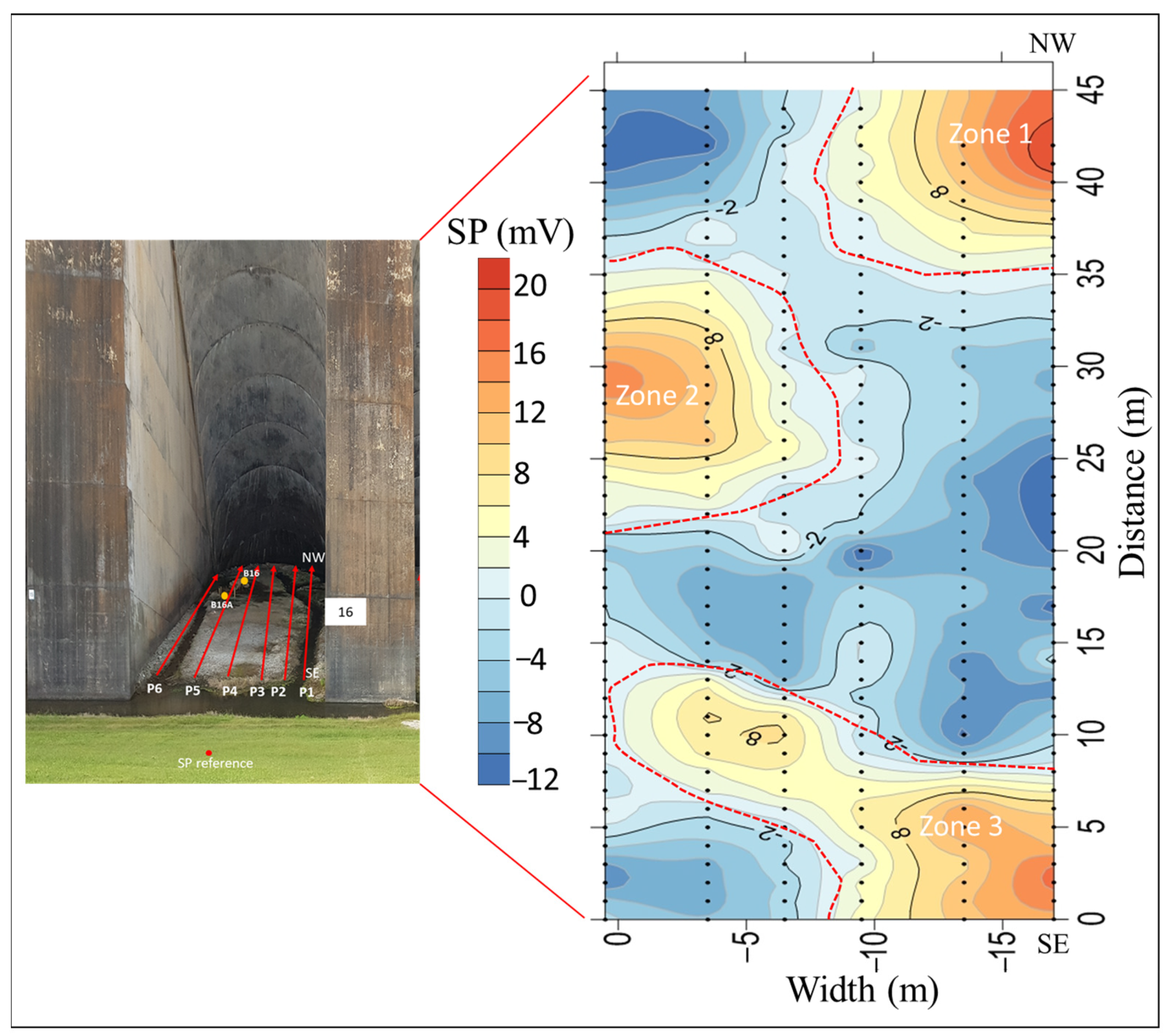
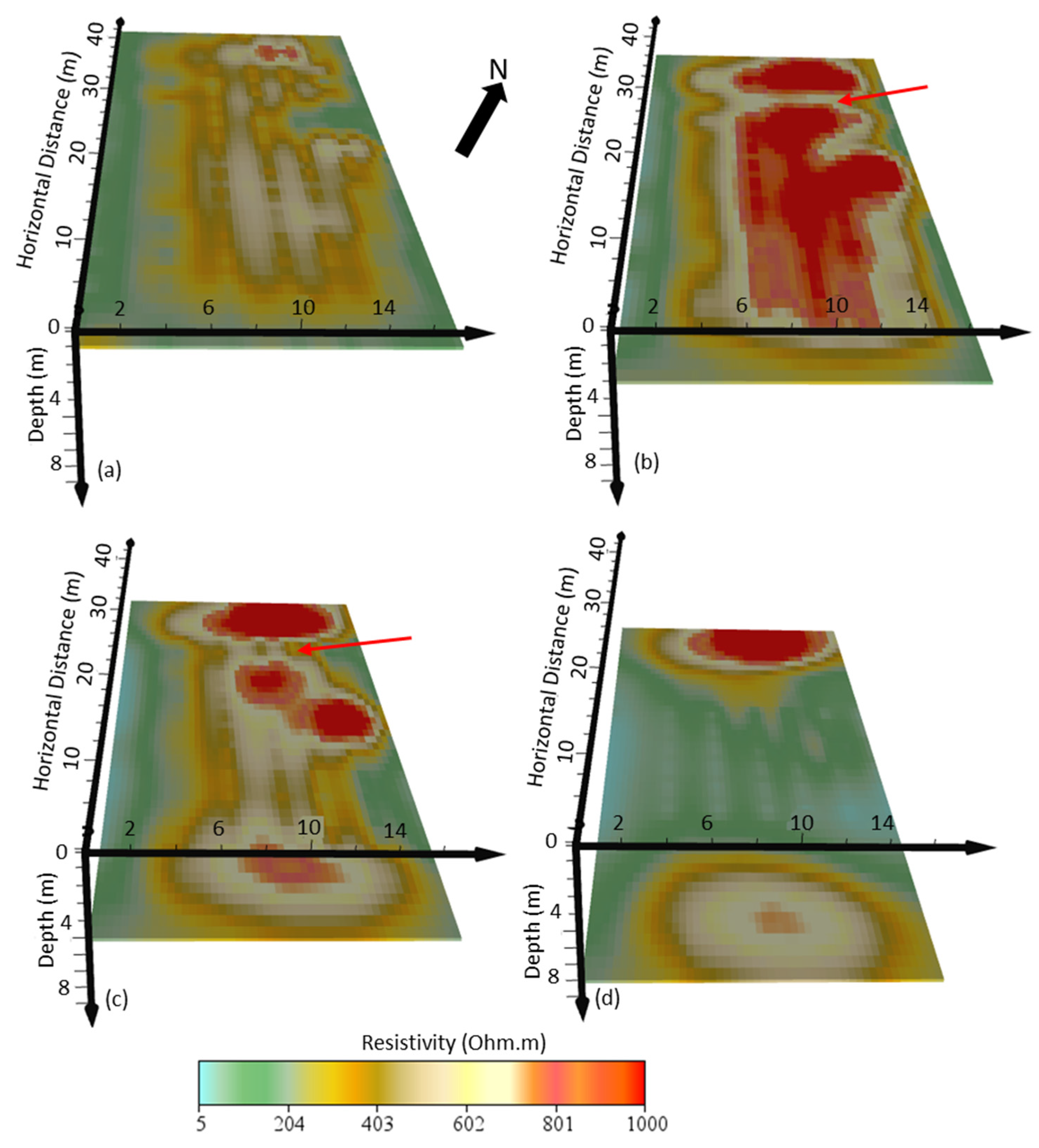
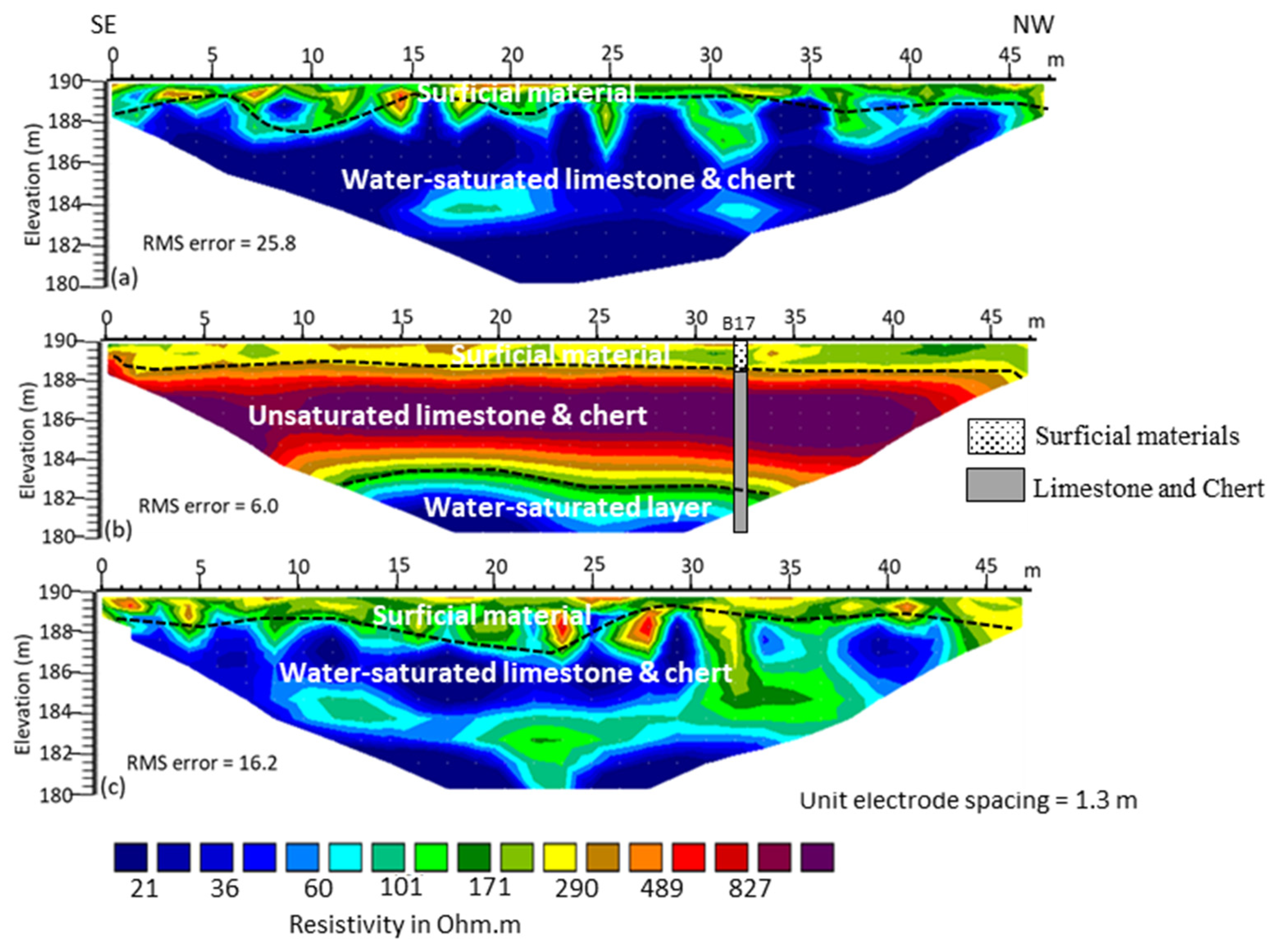
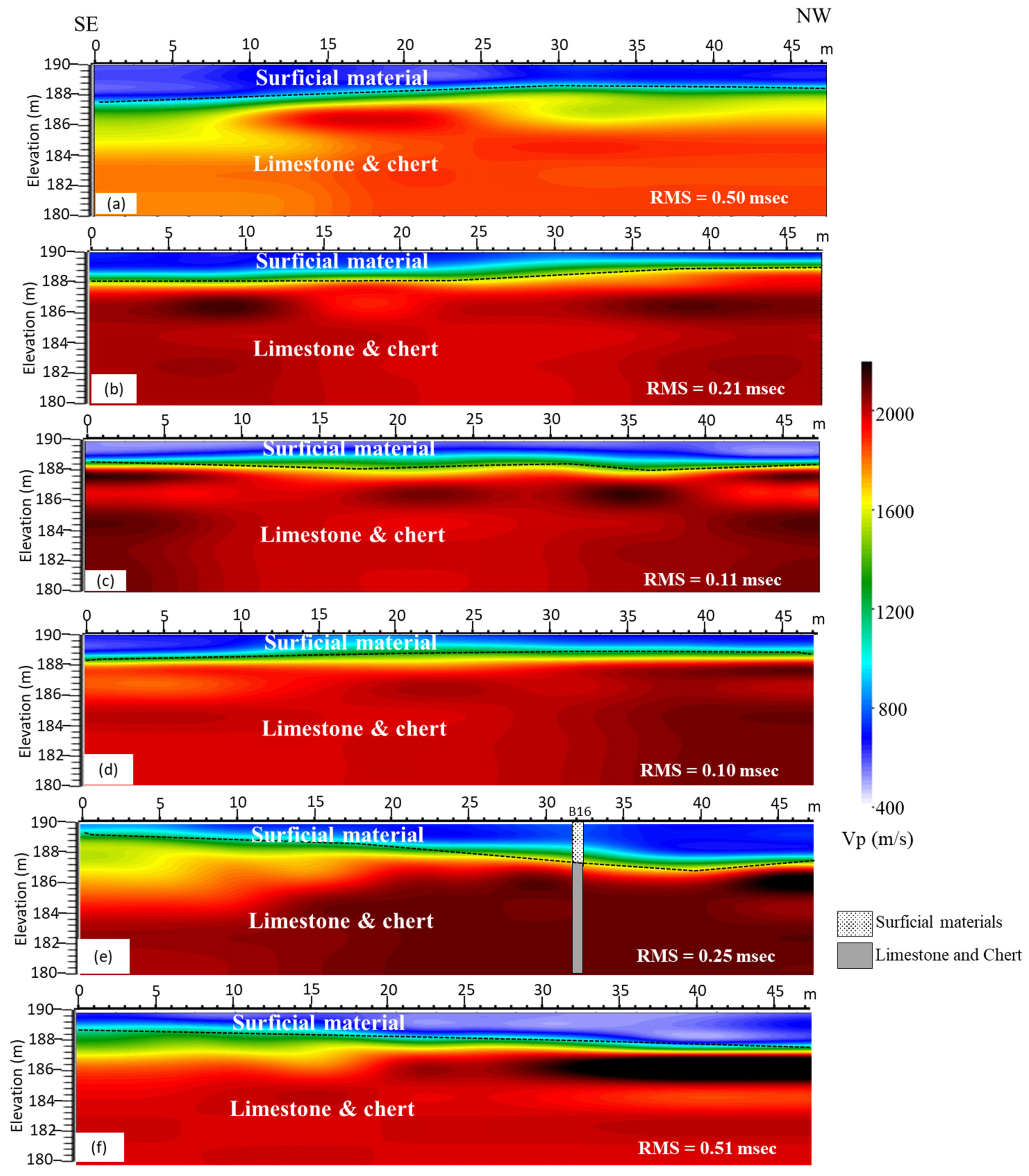
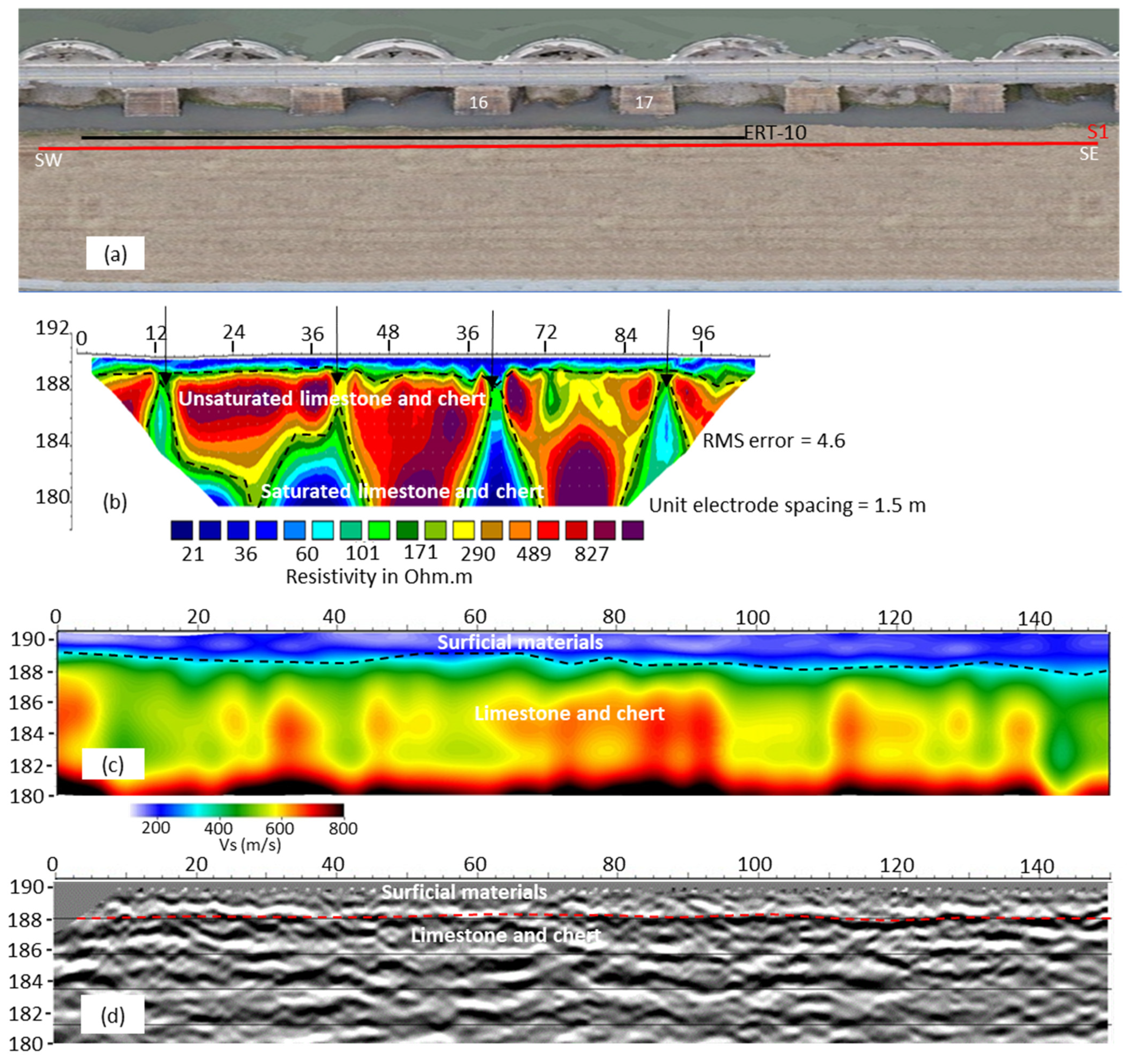
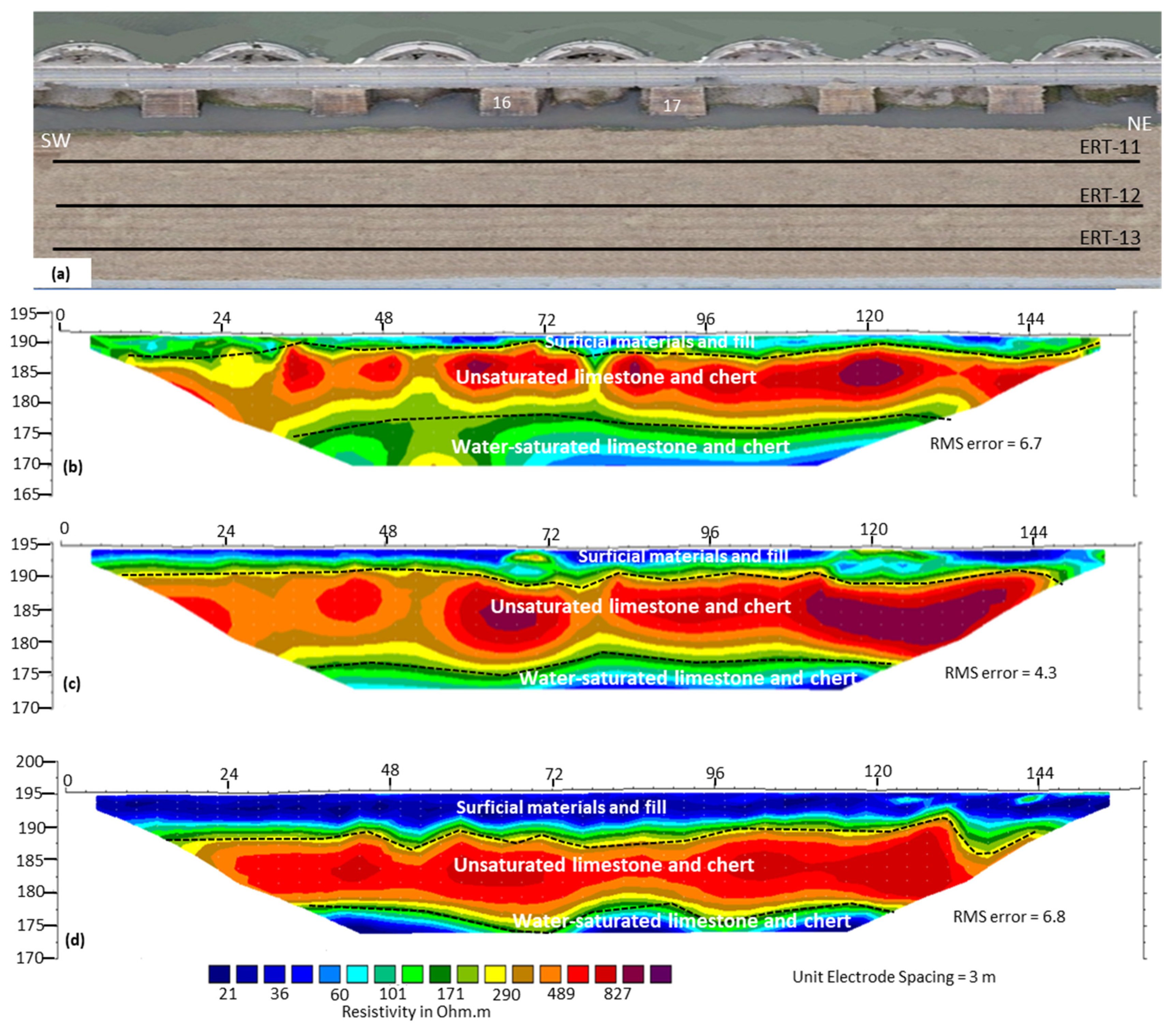
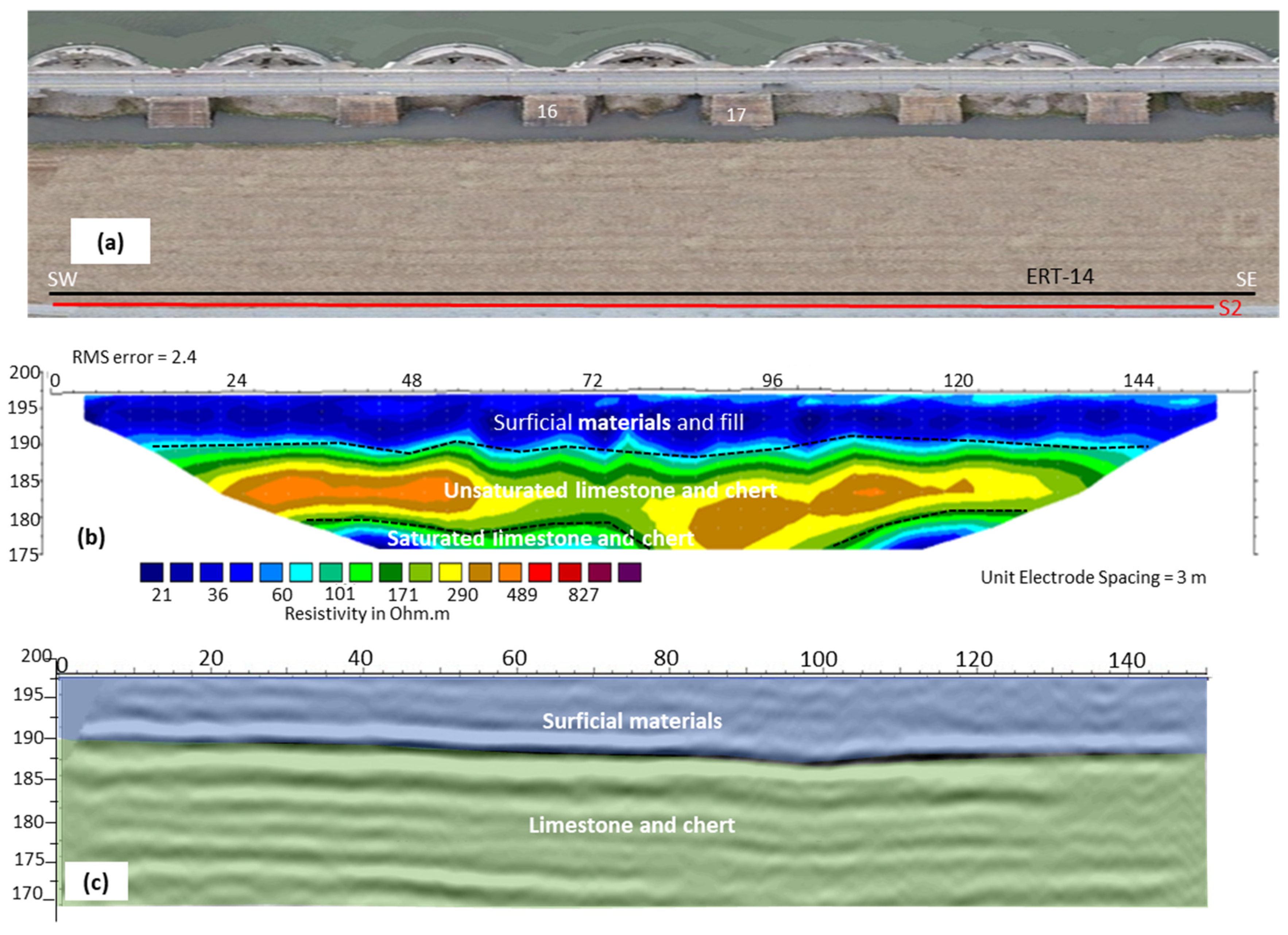
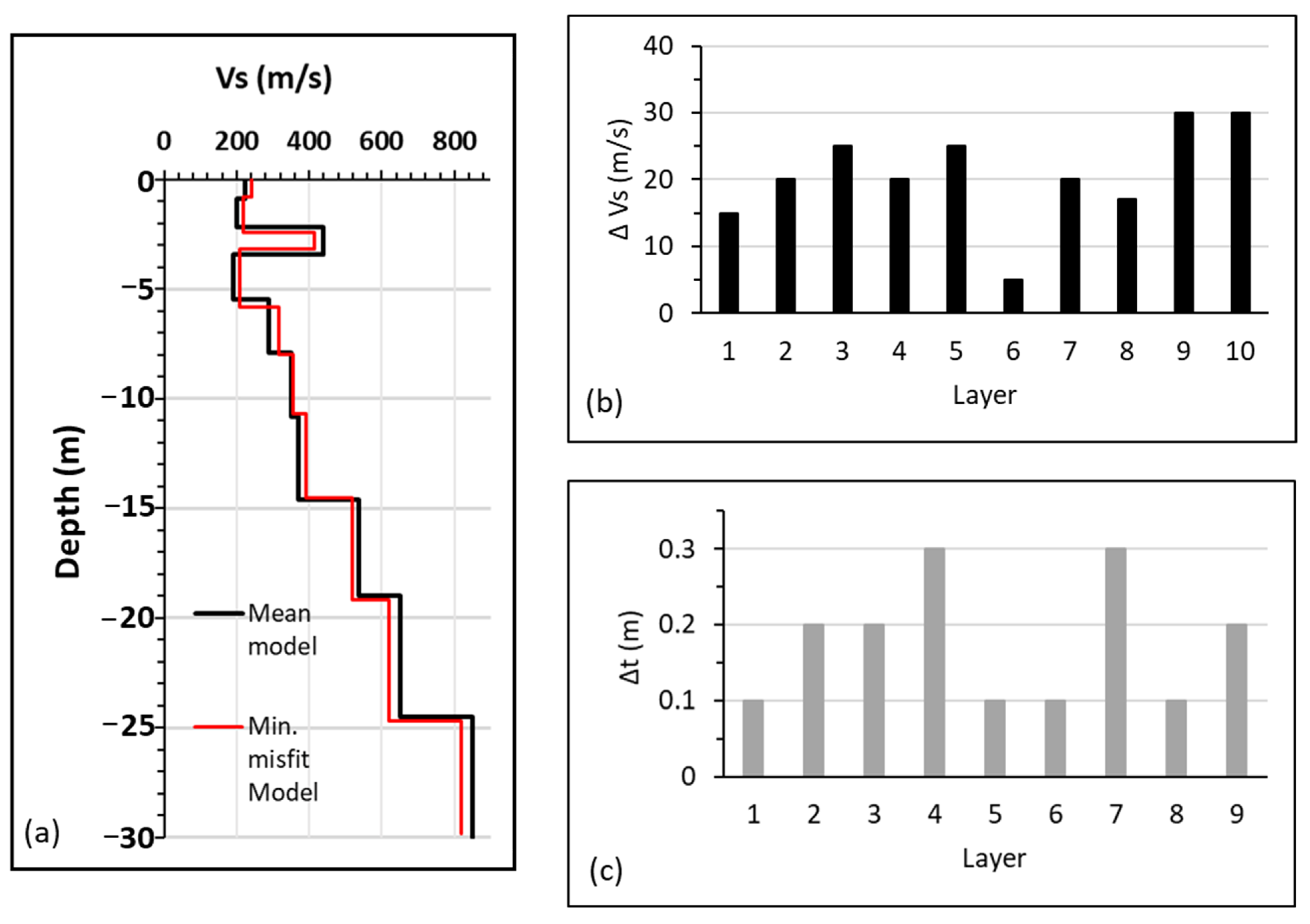
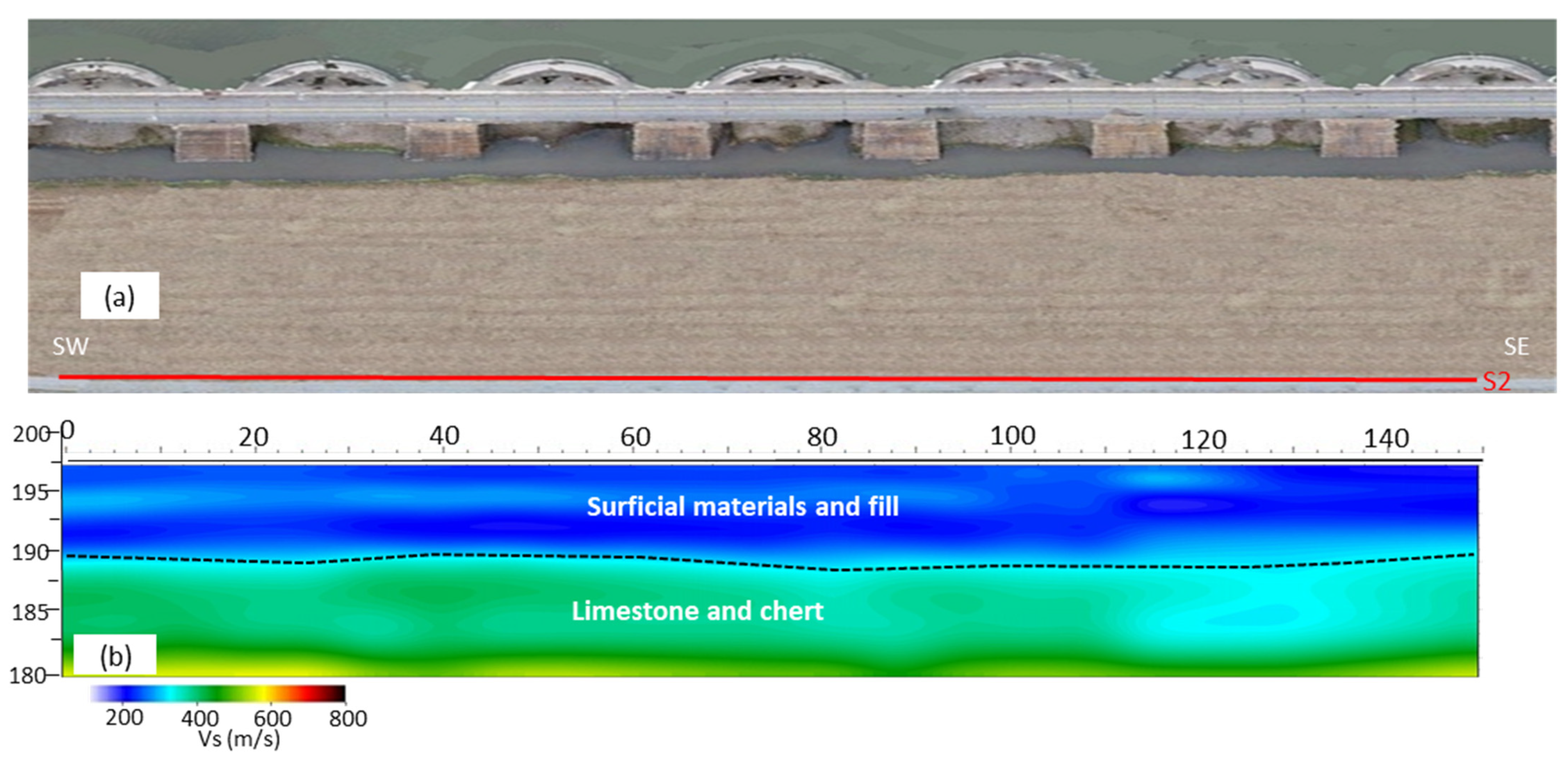


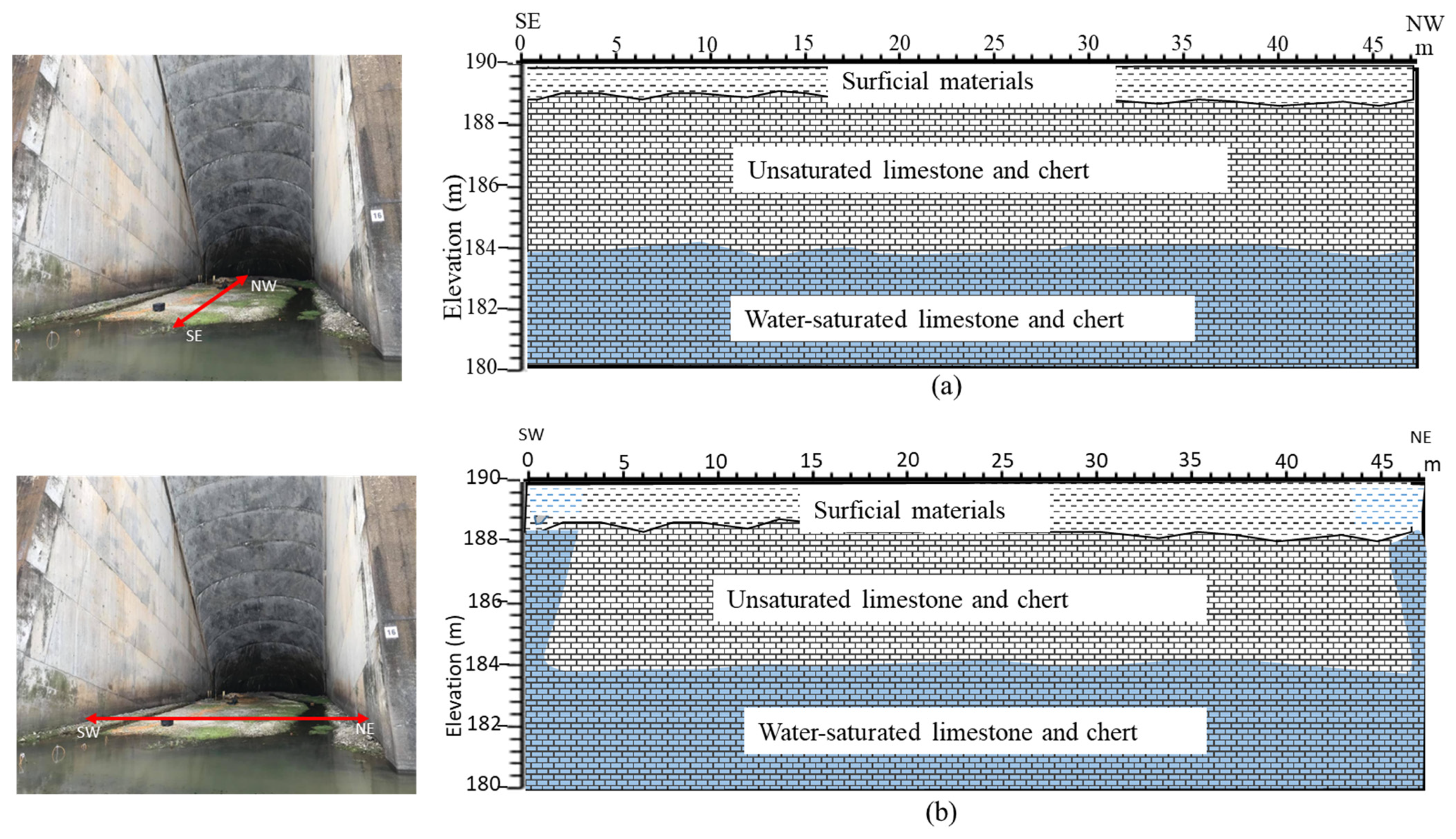
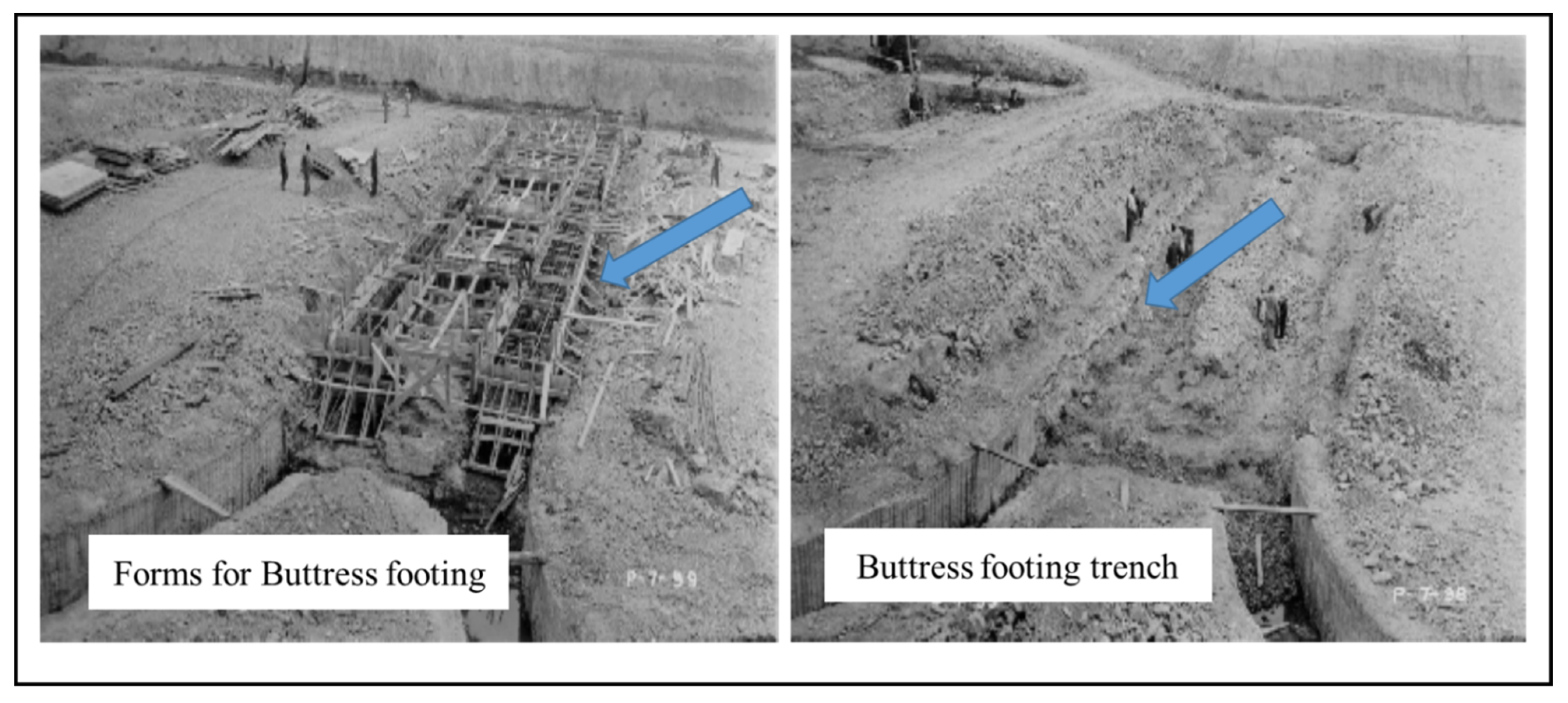
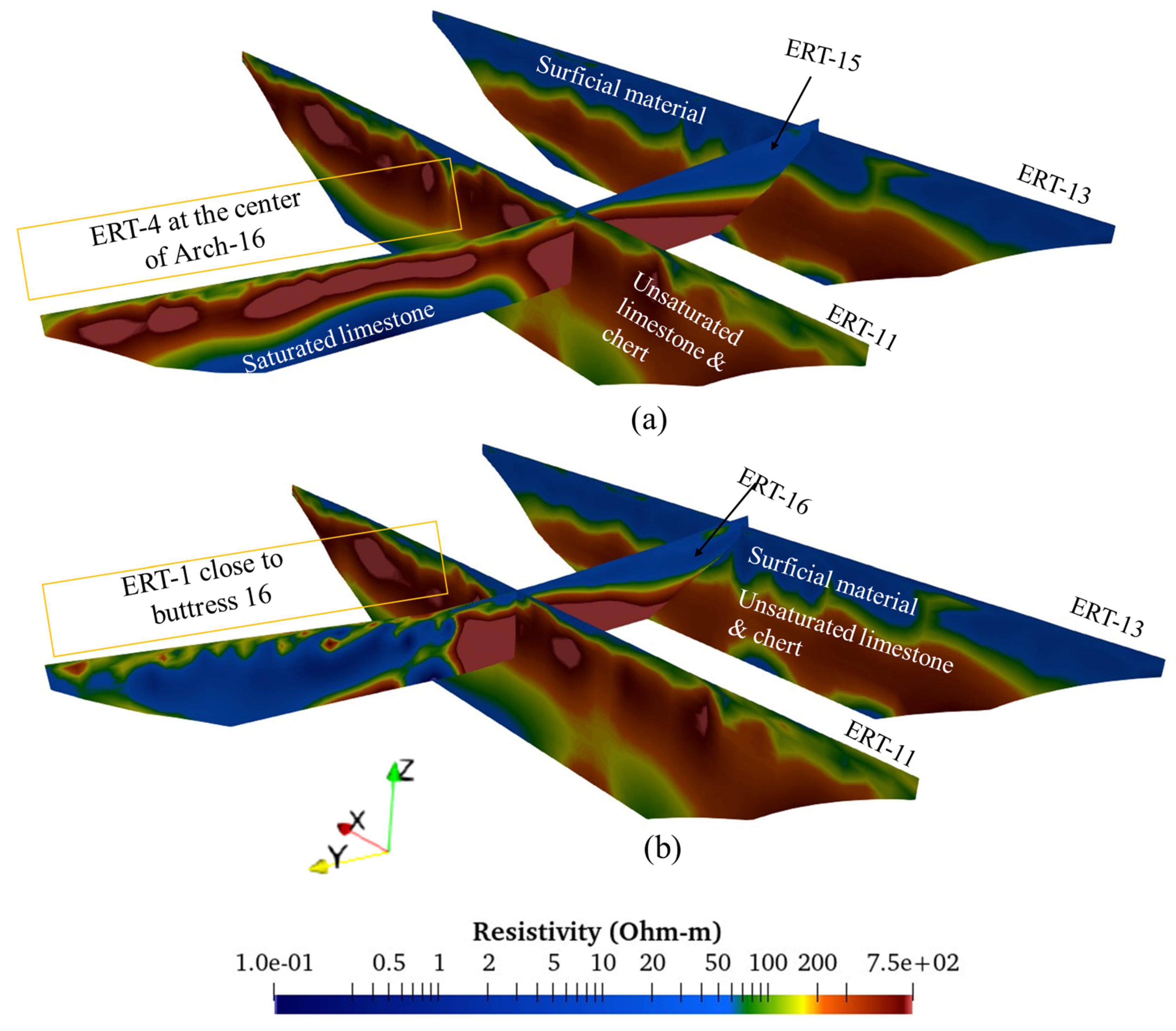
| Geophysical Technique | Acquisition Parameters |
|---|---|
| ERT | Electrodes: 36 steel electrodes spaced at 1.3 m (ERT-1 to ERT-9); 72 steel electrodes spaced at 1.5 m (ERT-10 and ERT-15 to ERT-16); 54 steel electrodes spaced at 3 m (ERT-11 to ERT-14); Type of array: Dipole–dipole; Instrument: Iris Syscal Pro72 resistivity meter. |
| SP | Electrodes: Two non-polarizing Cu/CuSO4 electrodes; Configuration: Fixed based; Station interval: 1 m; Number of stations: 270 stations; Instrument: Long wire and handheld Fluke 289 true RMS digital multimeter. |
| Seismic refraction | Geophones: 24 geophones (14 Hz) spaced at 2 m; Source: 10 kg sledgehammer and iron metal plate; Shots: 24 shots spaced at 2 m; Instrument: Geode Geometrics seismograph. |
| MASW | System: Land streamer; Geophones: 24 geophones (4.5 Hz) spaced at 1.5 m; Source: 10 kg sledgehammer and iron metal plate; Shots: 23 shots spaced at 6 m; Instrument: Geode Geometrics seismograph. |
| S-wave reflection | System: Land streamer; Geophones: 24 geophones (14 Hz) spaced at 0.75 m; Source: 2 kg sledgehammer and a rolling source; Shots: 90 shots spaced at 1.5 m; Instrument: Geode Geometrics seismograph. |
| S/N | Parameters | Grand Lake Surface | Grand Lake Benthic | Arch-16 Well | Arch-16 Spigot |
|---|---|---|---|---|---|
| 1 | Nitrate | 0.53 | 0.62 | 0.33 | 0.39 |
| 2 | Orthophosphorus | 0.24 | 0.34 | 0.28 | 0.59 |
| 3 | Total Hardness (TH) | 124.40 | 125.00 | 225.00 | 202.00 |
| 4 | Total Alkalinity (TA) | 118.80 | 125.20 | 193.00 | 205.00 |
| 5 | Bicarbonate | 118.80 | 125.20 | 193.00 | 205.00 |
| 6 | Na+ | 12.85 | 9.89 | 13.15 | 11.80 |
| 7 | Ca2+ | 41.60 | 41.25 | 60.10 | 59.45 |
| 8 | K+ | 3.20 | 3.52 | 2.58 | 2.58 |
| 9 | Mg2+ | 6.24 | 6.28 | 9.54 | 9.65 |
| 10 | Fe2+ | 0.07 | 2.49 | 0.97 | 0.56 |
| 11 | Mn2+ | 0.022 | 0.53 | 4.25 | 4.26 |
| 12 | Dissolved oxygen (DO) | 8.48 | 8.92 | 2.64 | 2.24 |
| 13 | TDS | 188.00 | 189.00 | 277.00 | 282.00 |
| 14 | Temperature | 13.55 | 12.68 | 13.24 | 13.11 |
| 15 | Electrical Conductivity (EC) | 226.30 | 222.70 | 330.40 | 334.80 |
| 16 | pH | 7.49 | 7.37 | 6.41 | 6.70 |
Disclaimer/Publisher’s Note: The statements, opinions and data contained in all publications are solely those of the individual author(s) and contributor(s) and not of MDPI and/or the editor(s). MDPI and/or the editor(s) disclaim responsibility for any injury to people or property resulting from any ideas, methods, instructions or products referred to in the content. |
© 2023 by the authors. Licensee MDPI, Basel, Switzerland. This article is an open access article distributed under the terms and conditions of the Creative Commons Attribution (CC BY) license (https://creativecommons.org/licenses/by/4.0/).
Share and Cite
Sanuade, O.; Ismail, A. Geophysical and Geochemical Pilot Study to Characterize the Dam Foundation Rock and Source of Seepage in Part of Pensacola Dam in Oklahoma. Water 2023, 15, 4036. https://doi.org/10.3390/w15234036
Sanuade O, Ismail A. Geophysical and Geochemical Pilot Study to Characterize the Dam Foundation Rock and Source of Seepage in Part of Pensacola Dam in Oklahoma. Water. 2023; 15(23):4036. https://doi.org/10.3390/w15234036
Chicago/Turabian StyleSanuade, Oluseun, and Ahmed Ismail. 2023. "Geophysical and Geochemical Pilot Study to Characterize the Dam Foundation Rock and Source of Seepage in Part of Pensacola Dam in Oklahoma" Water 15, no. 23: 4036. https://doi.org/10.3390/w15234036
APA StyleSanuade, O., & Ismail, A. (2023). Geophysical and Geochemical Pilot Study to Characterize the Dam Foundation Rock and Source of Seepage in Part of Pensacola Dam in Oklahoma. Water, 15(23), 4036. https://doi.org/10.3390/w15234036







